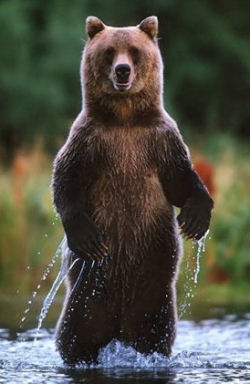The brown bears of the world include numerous subspecies in Asia, Europe, and North America. Even the polar bear, taxonomically, may be a white phase of the brown bear. Support for this concept is provided by new electrophoresic studies and the fact that offspring of brown/polar bear crosses are fertile. The interior grizzly (Ursus arctos horribilis) is generally smaller than the coastal (Ursus arctos gyas) or island (Ursus arctos middendorffi) subspecies of North American brown bear, and it has the classic “grizzled†hair tips.
Brown bears in general are very large and heavily built. Male brown bears are almost twice the weight of females. They walk with a plantigrade gait (but can walk upright on their hind legs), and have long claws for digging (black bears and polar bears have sharper, shorter claws). The males can weigh up to 2,000 pounds (900 kg), but grizzly males are normally around 400 to 600 pounds. Wherever brown bears live, their size is influenced by their subspecies status, food supply, and length of the feeding season. Bone growth continues through the sixth year, so subadult nutrition often dictates their size potential.
Brown bears are typically brown in color, but vary from pure white to black, with coastal brown bears and Kodiak bears generally lighter, even blond or beige. The interior grizzly bears are typically a dark, chocolate brown or black, with pronounced silver tips on the guard hairs. This coloration often gives them a silvery sheen or halo. They lack the neck ruff of the coastal bears, and grizzlies may even have light bands before and behind the front legs. Some particularly grizzled interior brown bears have a spectacled facial pattern similar to that of the panda or spectacled bears of Asia and South America.
White grizzlies (not albinos) are also found in portions of Alberta and Montana, and in south-central British Columbia. Such white brown bears may be genetically identical to the polar bear, but so far electrophoresic studies have not been completed to determine the degree of relatedness.
The interior grizzly’s “hump,†an adaptation to their digging lifestyle, is seen less in the coastal brown bears, polar bears, or black bears. The brown bears (including the grizzly) are also characterized by their high eye profile, dish-shaped face, and short, thick ears.
